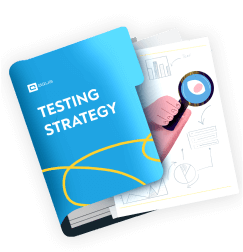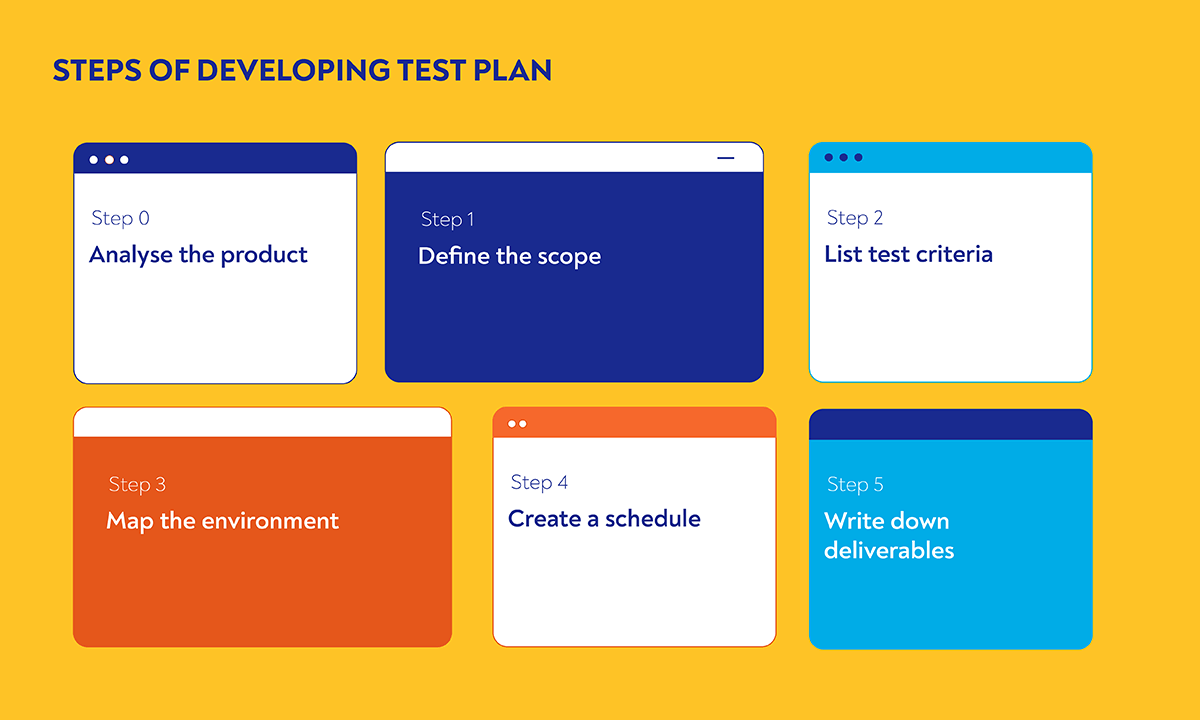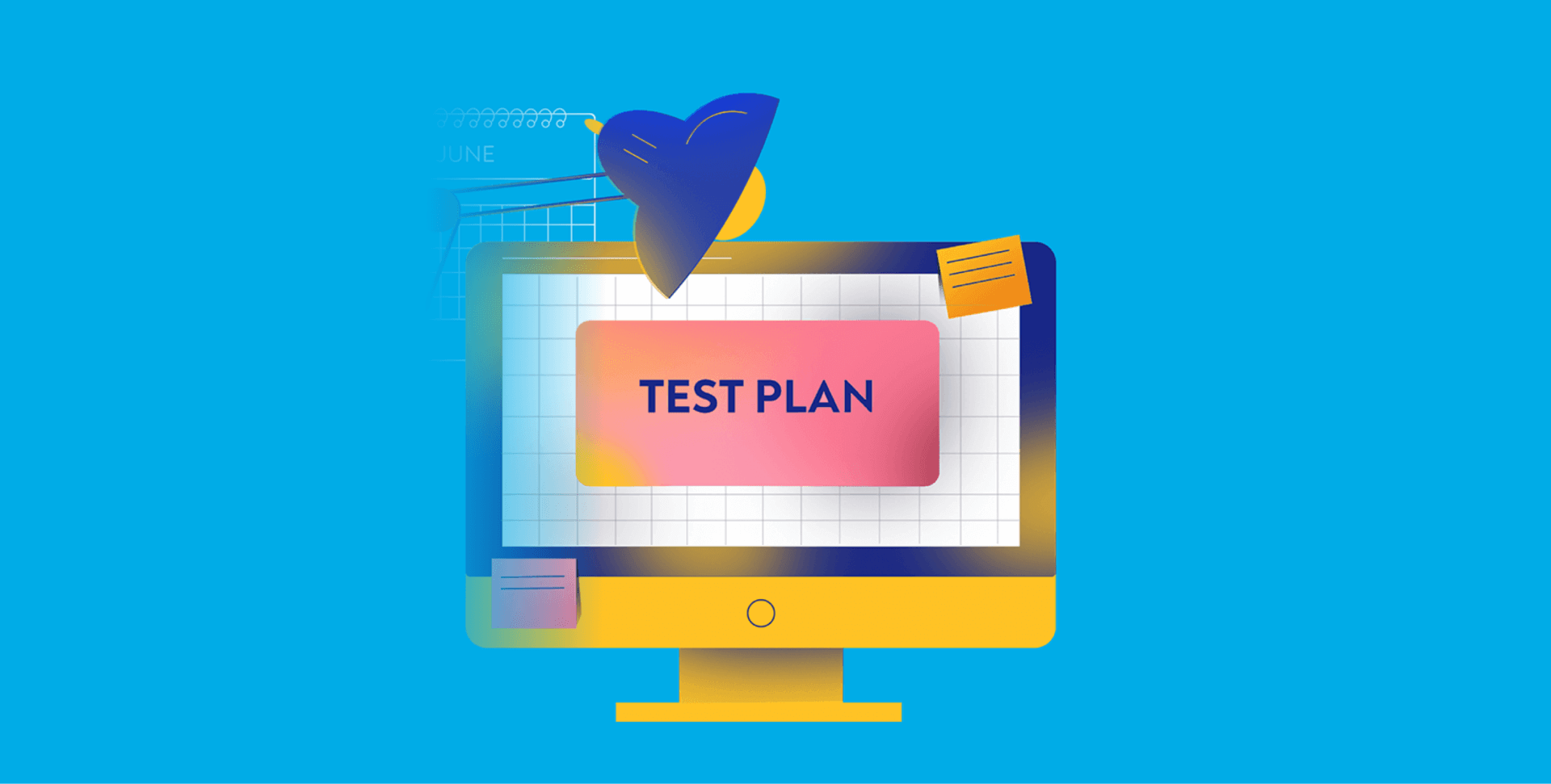What is a software test plan?

A test plan describes how your QA team will tackle testing a particular piece of the software product. A test plan includes objectives, schedule, deliverables, and resources required to achieve them. A quality test plan is well worth the time investment, as a careful approach yields good bug detection and mitigates QA-related time & financial risks.
The beauty of test plans lies in their practically company-wide reach. Few test plan components are particularly technical. The document is mostly accessible to all the stakeholders, painting a picture of quality assurance that resonates with everyone on the project. Testers generally tend to spend less time around their non-tech colleagues than developers, so providing a glimpse into QA work is on the list of benefits as well.
Test plan and test strategy: are they the same?
While some use the terms interchangeably, this screams conscious or unintended disregard for nuance. Test plans cover a rather narrow scope — they help to ensure that certain parts of the software are up to the standards. As the name suggests, test planning concerns the deliverables and getting there. The test strategy provides the big picture of why your QA specialists do all this.
To better illustrate the difference from test plans, here is what a test strategy could include:
- Technology stack used in the project and how it affects QA
- Project-wide technical risks
- Levels of testing (unless you go full Agile, of course)
- Types of testing
- General schedule aligning with product development timeline
Test Management Systems (TMS) are pivotal in orchestrating these vital aspects of software testing when considering testing plans and strategies. While test plans focus on specific software components and standards, TMS is a central hub for organising, structuring, and optimising the entire testing process. It ensures seamless coordination among team members, facilitating efficient communication, resource allocation, and timeline management. A TMS enhances testing through features like test case creation, version control, and comprehensive progress tracking, ensuring a systematic approach that boosts software quality and reliability.
Here comes aqua cloud – your ultimate solution for streamlined test planning. By merging essential features beyond traditional tools, aqua revolutionises your QA process. Here is how you are going to do it with aqua:
- Achieve 200% automation by eliminating routine in test case generation
- Create 100% traceable test planning & execution processes
- Go from fragmented testing to transparent & manageable process
- Get unparalleled customisation and adjust your system to follow your workflow
Say goodbye to multiple tools and hello to swift communication and transparency among teams. With AI integration, aqua auto-generates test cases aligned with your requirements. Experience a new era in testing efficiency and strategy.
Supercharge your QA and save 12.8 hours per tester weekly with aqua
What are the test plan requirements?
Like I mentioned, both the necessity for test plans and the plans themselves can be pretty fluid. Still, there are a few criteria that are wise to apply if you do create a test plan document.
- Conciseness. Avoid long sentences if possible. Introductory phrases should be omitted when possible. A test plan (unlike this article) is not a piece of prose: it’s a daily manual where fluff gets old pretty fast
- Structure. When you prepare test plan, take the time to organise the content in a neat manner. A good table of contents goes a long way, especially for frequent users that are not always in the context (e.g. programming staff)
- Readability. As mentioned earlier, your test plan should bring value to all stakeholders. Avoid the QA-specific jargon if you can. When you are the one to write test plan, get some feedback from non-tech colleagues to see if they stumble where they shouldn’t
- Adaptability. Things can go wrong, and not necessarily on the QA side of things. A setback on the product, design, or development teams will mean a setback for you. Account for such risks to keep the plan relevant
- Accuracy. Not everyone will be consulting the plan on a daily basis, especially if their job doesn’t require that. An incorrect statement may give some team members wrong ideas that stick with them for months
A test plan is written based upon what you want to measure, and ensure that the measure is tested. From there walk back into what is being done, why it is being done and how it will be used. Then you'll have an idea of what is required. From a classical perspective, this will be way too much work and will result in typically double the effort it took to code it.
Types of test plans in software testing
Test plans in software testing are like blueprints to guarantee the quality of a software product. They’re akin to guiding manuals, each with a specific purpose. Below are the types of test plans in testing:
- Functional Test Plan serves as the backbone of QA, meticulously detailing how to verify the software’s functionality. It is a comprehensive guide outlining the specific tests and procedures to ensure that every feature operates as intended. This detailed plan directs the testing process, specifying how each function should be tested to guarantee flawless performance.
- Integration Test Plan details how different modules or components of software interact when combined, and how you should test them. It outlines the specific scenarios and tests to ensure these integrated parts’ smooth functioning and compatibility. This plan is crucial in identifying potential issues or discrepancies that may arise when various software elements come together to guarantee seamless integration.
- Performance Test Plan outlines how to conduct tests to ensure the software meets the predetermined performance benchmarks. It evaluates how the software should behave under different workloads and how you test it. It helps you assess whether your software is a speedster or if it slows down under pressure.
- Security Test Plan focuses on testing how the software is safeguarded against potential cyber threats. It’s like a security audit, identifying vulnerabilities and ensuring the software’s resilience against breaches.
- Usability Test Plan is dedicated to assessing the user experience of the software. It helps you organise the strategy and execution plan for assessing the software’s user-friendliness and intuitiveness. This involves employing diverse testing methods, such as task analysis and user interaction studies, with the potential inclusion of user feedback. With this QA testing plan, you can aim to pinpoint any potential usability issues.
- Regression Test Plan is the safety net of changes. Whenever modifications or fixes occur, it explains how to ensure that new changes haven’t unintentionally disrupted the existing functionality. It’s your way of double-checking the stability.
Each plan is pivotal in QA, contributing to a robust, dependable software product. However, knowing when to create each test plan is not enough. You should also follow some documentation guidelines, which you’ll learn in the following paragraphs.
Test plan documentation standards
As you already know, before developing and testing a new product, the team must write a test plan detailing how they’ll check for any issues. However, this process should adhere to specific documentation standards.
But what are these standards? Well, test plan documentation standards are like the rulebook that ensures everyone speaks the same language in software testing. Here’s a rundown:
- Clarity: Focusing on clarity should be your priority when documenting a test plan. Make sure your plan is crystal clear, outlining what needs to be tested, how it will be tested, and who will do it. It’s like drawing a roadmap for your testing journey.
- Structured Approach: Think of your documentation like building blocks. Organise it logically, with sections dedicated to objectives, scope, resources, timelines, test cases, and risks. This structure ensures everyone knows where to find what they need.
- Detail-Oriented Style: Be thorough in your documentation. Include specifics about the test environment, tools, and methodologies used. It’s like painting a detailed picture of how the testing will unfold.
- Flexibility: While being detailed, allow room for flexibility. Things might change along the way, so your documentation should be adaptable. You should have a blueprint that can be modified without tearing the whole plan apart.
- Clear Responsibilities: Clearly define roles and responsibilities. Who does what, when, and how? It’s crucial for effective teamwork. Think of it as assigning specific tasks during a group project—everyone knows their part.
- Consistency: Stick to a standard format and language. Consistency avoids confusion and ensures everyone understands the document uniformly.
- Goal-oriented approach: Just like ensuring everyone in a conversation speaks the same language, a goal-oriented approach or style in defining all processes within the test plan is also crucial. Each process should not only describe the steps but also articulate the expected outcomes to be achieved.
Remember, test plan documentation is your guiding light throughout the testing process. The clearer, more structured, and more detailed it is, the smoother your testing journey will be!

Get a testing strategy template that allows you to release software twice as fast
Steps of developing test plan
Step 0: Analyse the product
This step may not be as relevant if you have been working on the project for a while. On the other hand, test plan development for a new project always means doing the homework. This is even more relevant if the team uses an automated software testing tool. The more you understand what makes the software tick, the more options for automation you will see.
It’s not just fellow QA specialists that should help you understand the product. Ask the product owner about the launch and high priority features, since quality may have been sacrificed in favour of speed. Talk to the project manager to see if they have been facing recurring issues. Ask developers where technical debt risks turning into a point of failure.
Step 1: Define the scope
Test plans are indeed not meant to cover everything about your product. You usually focus on the level of testing (e.g. unit or system testing) and may additionally limit yourself by the types of testing. Functional vs non-functional testing is often quite a distinction in itself.
Let’s look at banking software testing as an example. Your bank may have introduced a lifestyle section where clients can buy a concert ticket or reserve a table at a restaurant. Your bank also grants loyalty points for all transactions, including lifestyle purchases. If the task is to make sure that loyalty points are correctly granted for these new lifestyle purchases, your test plan concerns integration testing.
The test plan basically for thinking a bit, what/how/when etc. you will do during the tests. There can be different test plan levels from developer to UAT. Basically the test plan should be created and updated cooperating with the project manager, project owner.
Step 2: List test criteria
Once you know what to look for, it’s only logical to define what constitutes QA success and failure. Feel free to introduce benchmarks that are relevant to the scope. Some examples include defect rate percentage, test case pass rate, and threshold of severe open defects.
Find more test criteria in our article on when to stop testing.
Step 3: Map the environment
Now that we know both the scope and the criteria, it’s time to decide how you go about them. Write down all the tools that your team uses for software testing. Evaluate whether this suite is enough for the scope. Research and add new solutions if necessary.
Especially on a new project, extra care is needed when preparing QA team for test automation. Run the QA specialists by automation ideas that you gathered during the analysis stage. Make sure they are proficient enough with the necessary automation tools to carry out this vision. Resource planning can very well be part of this step even without automation.
Step 4: Create a schedule
The next step is to create a schedule of activities to fulfil the scope. Knowing the schedule of product and developer teams is 90% of creating your own schedule. Make sure to account for potential missed deadlines on both your and their ends.
Test automation can really help the planning effort. If individual modules are checked as development happens, your QA specialists spend less time sitting and waiting for the devs to send them the upcoming build. This time can be better spent on exploratory testing and, if necessary, making up for otherwise missed deadlines.
Step 5: Write down deliverables
All that’s left now is to formalise the expected output. The test plan that you may be writing right now is a deliverable as well. So are the new test cases that your team will make as well as any fruits of the automation labour.
Test results are arguably the ultimate deliverables, as they shape future QA and potentially bug resolving efforts. You may also come up with a way to present your work to non-QA colleagues at a certain milestone or the end of the sprint.

Conclusion
Test plan is a useful tool with advantages that go beyond QA effort. It formalises software testing, opens it up to other stakeholders, and helps navigate potential challenges within and outside the QA team. Great preparation does yield great results, and software quality assurance is no exception.
Your test plan also needs to be updated when there’s new tech to save time. The latest step of QA evolution is AI testing, and we have a solution for it. aqua AI copilot creates entire tests or complete drafts in no time. The more things you can delegate to AI, the better and/or faster you can cover all requirements.
Use AI to fit more deliverables into your test plan







